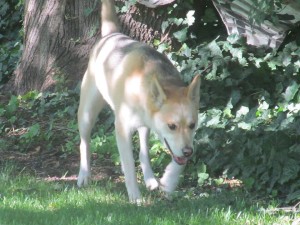
How about technological solutions for the human who trains alone?
Dog trainers have been using one solution about as long as there have been dogs—certainly as long as there have been leashes for dogs!
It’s as low tech as you can get—a long line.
A long line is a very long leash. It can be any length.
Leashes vary from four to six feet. Long lines vary from ten feet to fifty feet. The length you choose depends on how you plan to use it. Your best bet may not be the longest line because you’ll have to deal with the extra line you don’t need.
Twenty feet is a good choice for a starter long line. You may want to add more length as your training advances.
Long lines are sold in most chain pet stores, in local pet supply stores, and online. They are made of cotton, cotton canvas, leather, and a variety of synthetics. Usually, cotton canvas is a good choice. It’s easy on your hands, washable, and sturdy. Leather long lines are not for beginner dogs or beginner trainers. They are simply too expensive and too attractive to pups who like to chew. Synthetics can be very hard on your hands.
Cotton clothesline can be used as an inexpensive alternative to a long line around the house and yard, but it’s not particularly easy to roll up and carry around.
Long lines are very useful for working on recalls—coming when called—when your dog does not have a solid Wait and you don’t have a second person for a restraint recall.
In a fenced area, position your dog near a post or pole or tree.
Attach the long line to the dog’s buckle collar or harness.
1. Take the long line behind the dog and back around the post or pole.
2. Stand at an appropriate distance in front of the dog.
The dog may try to go with you or to anticipate the recall, but the long line will hold him back, away from you.
3. Drop the long line and call the dog.
To practice in an unfenced area, use two long lines—one around a post or pole behind the dog, the other in a straight line from the dog to you. Hold onto the second line, straight from the dog to you, and you will still have control of the dog.
It’s not easy to handle two long lines at once, especially if you’re trying to deliver treats or toys as a reward when the dog does the recall.
It takes practice—so practice!

High-tech equipment for dogs is very popular now, but It can be expensive.
I’m not going to recommend a drone to walk your dog or a camera that attaches to the dog to record what she sees from her exact angle of vision.
But some high-tech devices can be extremely helpful if you’re most often training alone. Some even work long-distance!
Devices that deliver food rewards to the dog at a distance from the trainer are very practical products.
Imagine that you want to reward your dog for staying away from the front door when the doorbell rings, so your visitors won’t be bowled over by a friendly fur ball.
The device sits on the floor where you want the dog to be. When you want to mark her success, you push the button on the remote controller and a food reward comes out, right where the dog is.
Remotely activated devices that deliver food treats can be also be used to reward your dog for quiet behavior in a crate or kennel without your having to return to the dog.
Instead, you sit in another room, listening. When the dog is quiet, you use the remote and, in the kennel, treats are delivered.
If you’re a truly tech-savvy dog owner, you might be tempted by remote-controlled reward devices that work over the Internet. You may have seen ads demonstrating their use.
In your home, a screen is mounted so that your dog can look right into it, to see you when you talk to him. You can see and hear him as well, on your phone or your computer.
From anywhere with wifi, you can choose to reward him with the delivery of treats while you praise his good behavior. Some variations on this design also deliver toys!
Your budget may dictate which of these devices you try.
NEXT WEEK: Your Pet’s ID



